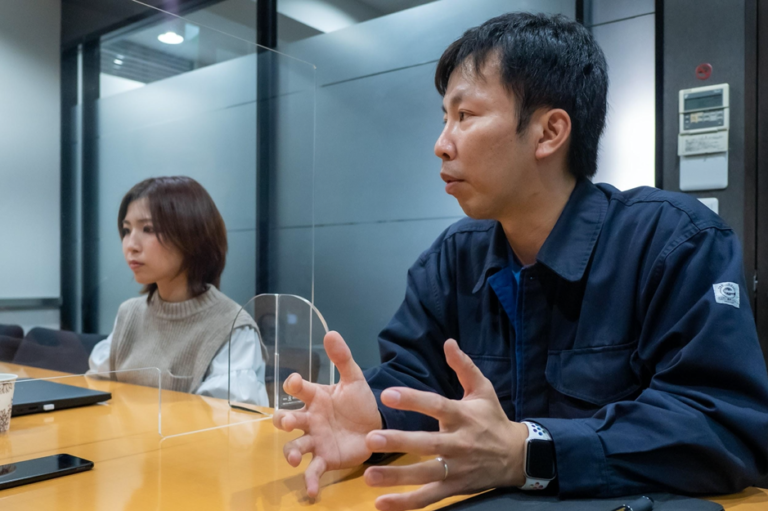360° Data Art Archive
Expectations for Interactions Across Time and Space
Background
The Media Center at Tama Art University, established in 2001, is responsible for digital archive production and information dissemination within the university.
We spoke with Muraho Shuji, who was a member at the time, and Akihiro Kubota, a professor in the Department of Information Design at Tama Art University and director of the art archive center, as they are working on digital archiving with RICOH THETA and THETA 360.biz.
The Potential of 360° Data for Archiving Art
When documenting artworks, there are times when you want to preserve the "space" itself, which cannot be fully conveyed by two-dimensional images or video. This is why we started taking 360° photographs to capture entire spaces.
Video is a temporal extension of photographs, and 360° images can be seen as a spatial extension of photographs. With the birth of multimedia art, the concept of an ‘installation’ was born as a work that constitutes an entire space. It is not just a discrete two-dimensional or three-dimensional work, but an entire space becomes a single work. If the installation can be photographed and preserved in a 360° image we can create a clear record of the work, making it easier to remember the work itself.

There is also a recent movement in the art world to capture and archive exhibitions in 360° to make them more attractive to visitors. There is a project called Art 360 (https://art360.place/) that archives exhibitions in 360° images.
Even on campus, it is possible to preserve the atmosphere and presence of the event itself, such as how it was set up, how it was presented, and what kind of people came. For example, we can shoot and observe the campus courtyard from a fixed point and leave it as content that can be manipulated in real time. The time period remains as a record of the space.
By creating a kind of university lifelog archive of how the media and forms of expression that students use in their work are changing, and by recording this in a 360° format, it is possible for students to track how their work changes over time.
Digital archives are useless if they cannot be easily created and maintained
In 2003, I started to create an archive using VR. At the time, there were no 360° cameras, and we had to use a fisheye lens to shoot front, back, left, and right, and then stitch the images together. It used to take three to four hours just to stitch one 360° image, but RICOH THETA made it possible in one shot. We also used to take a whole day to create VR tours which can now be produced in about an hour using THETA360.biz with a preview on the website. Archives are meant to be ongoing and it is very important that they are easy to create and can be passed on to younger generations.

Expectations for interaction through 360° art archives
More and more students are incorporating 3D and VR into their work, such as 3D hand drawn animation using VR headset displays. We discuss what possibilities and meanings there are when new media such as 360° cameras appear on the market. New media have the potential to allow the creation of new artworks that we haven’t seen yet.
At art universities, there are many critiques sessions and exhibitions of student works, and something is held somewhere on a weekly basis. There are also special exhibitions for research activities and exhibitions to commemorate the retirement of faculty members.
However, there are surprisingly few opportunities for students to see other students' works. Working together in different fields will broaden our horizons. There is a possibility that variations and diversity of works, as well as hybrid works, will be created.
In some works, there are installations that combine not only two-dimensional and three-dimensional work, but also video, electronic devices, and programming as well. In fact, students study installation in oil painting classes, create videos even though they specialize in sculpture, and paint watercolors in photoshop. We think there are interesting themes at the intersection of disciplines in this way.
A 360-degree approach would have the potential to facilitate mutual work through encounters with new technologies, as well as stimulation by each other's work, or past work, and collaboration with each other by recording in 360 degrees.
We hope that our digital archiving efforts will encourage interaction between these new fields and create new themes, and that it will grow into a medium that connects art and technology.
Professor Kubota is currently leading the Tama Art University Art Archive Center as its director. The center aims to create interaction between archival materials and creators, and to build and provide archives that encourage the creation of new works and ideas. 360° data can be used to cut out the place itself and elevate it beyond time and space, making it possible to work with each other outside temporal and spatial limitations. In installations, where the space itself becomes the work of art, events, exhibitions, and everything that happens, gives some kind of stimulus to the creator, which may lead to new works. As a medium that makes possible the interaction between archival materials and creators that Professor Kubota is aiming for, 360° data will have its place in the field of art.
Samples in THETA360.biz
https://www.theta360.biz/cases/747/
※Photoshop is the trademark or a registered trademark of Adobe Systems Incorporated in the United States and other countries.




.jpg)


.svg)




